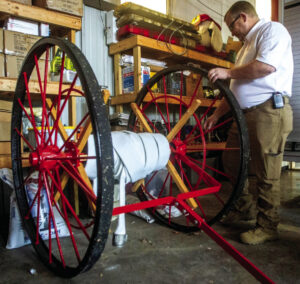Phil Campbell: Town’s name pays homage to 1800s train engineer
PROGRESS 2023: What’s In A Name
The history of the Town of Phil Campbell is extensive, but “Place Names in Alabama” by Virginia O. Foscue puts it pretty succinctly: “Named for Philip Campbell, the contractor who built the Birmingham, Sheffield and Tennessee River RR through this area in 1886. L.M. Allen, one of the first settlers, had promised to name the town for Campbell if the latter built a spur track and depot here.”
A February 1976 publication of the “Phil Campbell Reflector,” recounts how Mel Allen, “the area’s most prominent merchant,” made it a personal goal to have the railroad pass by the vicinity of his store, to build up a town in that location. Allen connected with engineer/contractor Philip Campbell to make his dream a reality, with the interesting offer to name the town after the latter, if he made it happen. He reportedly “told Mr. Campbell if he would build a depot and put in a side track” that he would name the town for him.
Phil Campbell is the only town in Alabama to have both the first and last name of a person. “So, Phil Campbell might have had an entirely different name if it had not been for the Allen family of Franklin County,” the “Reflector” surmises.
“I think that’s unique,” said Councilwoman Lynn Landers. Landers has, in the past few years, founded the Phil Campbell Arts and Historical Society in Phil Campbell, with an eye toward preserving the town’s history. “I don’t think we would be a town (without the railroad) – maybe a smaller community like Spruce Pine or Bear Creek. I think it actually helped put us on the map.”
It certainly did. The depot in Phil Campbell was a busy place. It had a waiting room, a ticket office and a freight room. The heat was coal in a “pot bellied” stove. There was a sand box around the stove to protect the floor but was used as a place to spit tobacco and snuff.
According to historical accounts, “all the cotton, cross-ties, etc. were shipped out on the R.R. All work of laying track, building bridges and trestles was done by hand by the men … Anyone going shopping, visiting, etc. went on the trains. Students that went to Florence Normal School (now U. of N.A.) went back and forth on the train.” A 2006 article in the TimesDaily newspaper records the railroad also transported “sandstone from Fern Quarry (near Littleville) and limestone from Rockwood (south of Russellville) to Sheffield.”
“Campbell was listed as manager of the railroad in newspaper ads dated 1894,” the TimesDaily article notes.
Campbell was born in Liverpool, England, in 1848. He is sometimes referred to as “Maj. Phil Campbell,” though the precise implication of the title is uncertain.
According to the “Reflector,” he did live in Phil Campbell for some years. He was also at one time mayor of Sheffield. He died in New Orleans June 30, 1932, at 84 years of age.
Landers said she hopes to visit his gravesite when she makes an upcoming trip to New Orleans. A photo of the site would be a good addition to the historical society’s memorabilia. The society is in the process of purchasing/renovating the former city hall in downtown as a facility to house memorabilia and display local art. Landers said the building has to be gutted, re-wired and re-plumbed, and it needs a new roof, but the society hopes to restore it to its former glory. “It’s going to take a while,” she added. The importance of the society’s mission, however, drives the progress. “Things get forgotten – especially by the young people of today. There’s a lot of things that are not on the internet, and this way they can just come into the building and see it.”
An old newspaper article, dated June 26, 1924, recounts an occasion when Campbell returned from New Orleans to the town bearing his name for a visit. He “was in the city last week to visit with his old friends here, among whom are Mr. C.E. Wilson and Mr. J.H. Walston, of the Wilson Mercantile Company. At the time the Major was building the railroad here he purchased many thousands of dollars worth of goods from the Wilson company and became warm personal friends of Mr. Walston and Mr. Wilson. At that time Russellville was just a small country village. Maj. Phil Campbell was in complete charge of the railroad at that time. His old friends here were glad to see him in our city again.”
Today the railroad is owned by Norfolk Southern, which “owns and operates a network of 19,500 miles of rail lines east of the Mississippi River in 22 U.S. states and the District of Columbia,” according to its website.
The town was incorporated in 1915.







